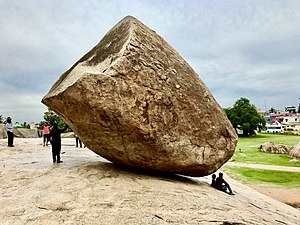
Amidst the lustrous rubies and sparkling emeralds that are apparently more precious than the lives of humans in this materialistic world, the granites have been relegated to a class of stones which are mostly used in making floor tiles, paving stone or stair treads only to be walked over. However, one granite rock valiantly challenged the status quo and attracted worldwide attention for its mysterious deed, thereby conveying a powerful message for humans that a person’s worth is determined by his deeds and not his lineage. Philosophies apart, this granite boulder does hold great significance.
Perched on a steep slope on top of a 1-2 meter high plinth in the town of Mahaballipuram in Tamil Nadu, this gigantic boulder stands 20 feet high and 16 feet wide, balancing its over 250 tons of weight for the past 1200 years. The boulder is bigger and heavier than the monolithic stones of Ollantaytambo and Machu Picchu of Peru. While the children embrace the existence of gravity and use the same slippery slope as a slide, the boulder defies this Newton’s law and refuse to budge. The precarious stone does have a name, a peculiar one rather. It is called as Krishna’s Butterball. The story goes that in 1969, a tourist guide credited this name to former Prime Minister of India, Indira Gandhi who was on a tour of the city. According to Hindu mythology, lord Krishna was a notorious kid and fond of stealing butter. While he was busy enjoying the fruit of his theft, a bit of it fell from heaven and has stayed on Earth since then. Though, the original name is ‘Vaan Irai Kal’ that translates from Tamil as ‘Stone of Sky God’, the former title is more approved of.
Approval to the boulder, incidentally, has been challenged many times in the past. A great number of attempts were made to move the boulder that (to some people) seemed to sabotage the beautiful landscape with its obnoxious presence. History has it that in 1908, when India slogged in serfdom under its colonial masters, then-governor of the city Arthur Havelock used seven elephants to dislocate the boulder but with no success. It did not move an inch then and remain adamant today when tourists gather like an army of ants to slide it off the slope by the virtue of their synergized muscle power. Although this butterball refused to acknowledge the strength of humanity, it did give in to the ravages of erosion that consumed its top back making it look like a half-spherical rock.
Nonetheless, its distorted figure continued to attract tourists from around the world and eventually landed Mahaballipuram city in the list of UNESCO World Heritage Sites. As the popularity of this rock grew, so did the interest of scientists and geologists and there began a string of theories to unravel the mystery. Some scientists explain that friction prevents the rock from rolling down and the center of gravity allows the rock to balance on the small contact area. On the other hand, geologists described this boulder as a ‘ventifact’ which is a stone shaped by erosive action of wind-blown sand. The wind is a potent force of nature which carries particles of sand and blasts them on a surface. This process of wind abrasion hits the rocks with sand particles. When wind hits the rock with such particles, it smoothens one side of the rock. When the direction of the wind changes, it flattens the other side and give a peculiar shape to the rock which is called a ventifact.
However, in the state of Tamil Nadu which is a home to 38,615 temples of which some being as old as 5000 years, there is little room for such scientific theories to sustain. Therefore, people tend to turn a blind eye to logic and get dazzled by this interesting rock.
Apart from common citizenry, kings and courtiers too, at some point of time, marvelled at this wonder. Recordings from the past show that the Indian Tamil king Raja Raja Chola was greatly inspired by the balance of this massive stone boulder and this gave birth to the never-falling mud dolls. ‘Tanjavur Bommai’ was the name given to such dolls which, having a half-spherical base tend to come back at their original position every time one tries to make them fall.

As the popularity grew, so did the flock of tourists year after year and it was included in the list of must-visit sites in Tamil Nadu by Travel bloggers. Therefore, this boulder, though made of granite stone is much precious than any bunch of rubies and emeralds for it makes our incredible India a little more incredible, a little more enchanting.
By RIDDHI JOSHI ,JAIPUR (RAJASTHAN)


